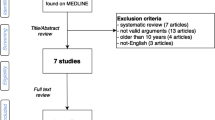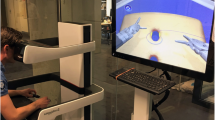Abstract
Purpose
Arthroscopy has assumed an important place in wrist surgery. It requires specific operative skills that are now mainly acquired in the operating room. In other fields of endoscopic surgery, e-learning and virtual reality (VR) have introduced new perspectives in teaching skills. This leads to the following research question: Could the current way of teaching wrist arthroscopy skills be supported using new educational media, such as e-learning and simulator training?
Method
The literature was searched for available methods of teaching endoscopic skills. Articles were assessed on the evidence of validity. In addition, a survey was sent to all members of the European Wrist Arthroscopy Society (EWAS) to find out whether hand surgeons express a need to embrace modern educational tools such as e-learning or simulators for training of wrist arthroscopy skills.
Results
This study shows that the current way of teaching wrist arthroscopy skills can be supported using new educational media, such as e-learning and simulator training. Literature indicates that e-learning can be a valuable tool for teaching basic knowledge of arthroscopy and supports the hypothesis that the use of virtual reality and simulators in training enhances operative skills in surgical trainees. This survey indicates that 55 out of 65 respondents feel that an e-learning program would be a valuable asset and 62 out of the 65 respondents are positive on the additional value of wrist arthroscopy simulator in training.
Conclusion
Study results support the need and relevance to strengthen current training of wrist arthroscopy using e-learning and simulator training.
Level of evidence
V.

Similar content being viewed by others
References
Bayona S, Fernandez-Arroyo JM, Martin I, Bayona P (2008) Assessment study of insight ARTHRO VR® arthroscopy virtual training simulator: face, content and construct validities. J Robot Surg 2:151–158
Beux PL, Fieschi M (2007) Virtual biomedical universities and E-learning. Int J Med Inform 76:331–335
Bhatti I, Jones K, Richardson L, Foreman D, Lund J, Tierney G (2011) E-learning vs lecture: which is the best approach to surgical teaching? Colorectal Dis 13:459–462
Bridges M, Diamond DL (1999) The financial impact of teaching surgical residents in the operating room. Am J Surg 177:28–32
Carroll C, Booth A, Papaioannou D, Sutton A, Wong R (2009) UK Health-care professionals’ experience of on-line learning techniques: a systematic review of qualitative data. J Cont Educ Health Prof 29:235–241
Citak M, Calafi A, Kendoff D, Kupka T, Haasper C, Behrends M, Krettek C, Matthies HK, Hüfner T (2009) An internet based learning tool in orthopaedic surgery: preliminary experiences and results. Technol Health Care 17:141–148
Cook DA, McDonald FS (2008) E-learning: is there anything special about the “E”? Perspect Biol Med 51:5–21
Cook DA, Levinson AJ, Garside S, Dupras DM, Erwin PJ, Montori VM (2010) Instructional design variations in internet-based learning for health professions education: a systematic review and meta-analysis. Acad Med 85:909–922
Curry JI (2011) ‘See one, practise on a simulator, do one’: the mantra of the modern surgeon. S Afr J Surg 49:4–6
Desai T, Christiano C, Ferris M (2011) Understanding the mobile internet to develop the next generation of online medical teaching tools. J Am Med Inform Assoc 18:875–878
Dunkin B, Adralas GL, Apelgren K, Mellinger JD (2007) Surgical stimulation: a current review. Surg Endosc 21:357–366
Farnworth LR, Lemay DE, Wooldridge T, Mabrey JD, Blaschak MJ, DeCoster TA, Wascher DC, Schenck RC (2001) A comparison of operative times in arthroscopic ACL reconstruction between orthopaedic faculty and residents: the financial impact of orthopaedic surgical training in the operating room. Iowa Orthop J 21:31–35
Gaba DM (1992) Improving anesthesiologists’ performance by simulating reality. Anesthesiology 76:491–494
Gallagher AG, McClure N, McGuigan J, Ritchie K, Sheehy NP (1998) An ergonomic analysis of the fulcrum effect in the acquisition of endoscopic skills. Endoscopy 30:617–620
Gallagher AG, Ritter EM, Champion H, Higgins G, Fried MP, Moses G, Smith CD, Satava RM (2005) Virtual reality simulation for the operating room: proficiency-based training as a paradigm shift in surgical skills training. Ann Surg 241:364–372
Gomoll AH, Pappas G, Forsythe B, Warner JJP (2008) Individual skill progression on a virtual reality simulator for shoulder arthroscopy: a 3-year follow-up study. Am J Sports Med 36:1139–1142
Grantcharov TP, Kristiansen VB, Bendix J, Bardram L, Rosenberg J, Funch-Jensen P (2004) Randomized clinical trial of virtual reality simulation for laparoscopic skills training. Br J Surg 91:146–150
Grechenig W, Fellinger M, Fankhauser F, Weiglein AH (1999) The Graz learning and training model for arthroscopic surgery. Surg Radiol Anat 21:347–350
Gurusamy KS, Aggarwal R, Palanivelu L, Davidson BR (2008) Systematic review of randomized controlled trials on the effectiveness of virtual reality training for laparoscopic surgery. Br J Surg 95:1088–1097
Haque S, Srinivasan S (2006) A meta-analysis of the training effectiveness of virtual reality surgical simulators. IEEE Trans Inf Technol Biomed 10:51–58
Harden RM (2006) Trends and the future of post-graduate medical education. Emerg Med J 23:789–802
Hart R, Karthigasu K (2007) The benefits of virtual reality simulator training for laparoscopic surgery. Curr Opin Obstet Gynecol 19:297–302
Howells NR, Gill HS, Carr AJ, Price AJ, Rees JL (2008) Transferring simulated arthroscopic skills to the operating theatre: a randomised blinded study. J Bone Joint Surg Br 90:494–499
Hugenholtz NIR, de Croon EM, Smits PB, van Dijk FJH, Nieuwenhuijsen K (2008) Effectiveness of e-learning in continuing medical education for occupational physicians. Occup Med 58:370–372
Hurmusiadis V, Rhode K, Schaeffter T, Sherman K (2011) Virtual trainer for minimally invasive surgery. Stud Health Technol Inform 163:236–238
Khan MS, Ahmed K, Gavazzi A, Gohil R, Thomas L, Poulsen J, Ahmed M, Jaye P, Dasgupta P (2013) Development and implementation of centralized simulation training: evaluation of feasibility, acceptability and construct validity. BJU Int 111:518–523
Kneebone RL (1999) Twelve tips on teaching basic surgical skills using simulation and multimedia. Med Teach 21:571–575
Larvin M (2009) E-learning in surgical education and training. ANZ J Surg 79:133–137
Lau F, Bates J (2004) A review of e-learning practices for undergraduate medical education. J Med Syst 28:71–87
Levinson AJ, Weaver B, Garside S, McGinn H, Norman GR (2007) Virtual reality and brain anatomy: a randomised trial of e-learning instructional designs. Med Educ 41:495–501
Mabrey JD, Gillogly SD, Kasser JR, Sweeney HJ, Zarins B, Mevis H, Garrett WE, Poss R, Cannon WD (2002) Virtual reality simulation of arthroscopy of the knee. Arthroscopy 18:E28
Mabrey JD, Reinig KD, Cannon WD (2010) Virtual reality in orthopaedics: is it a reality? Clin Orthop Relat Res 468:2586–2591
Marshall S www.elearningeuropa.info
Martin KD, Belmont PJ, Schoenfeld AJ, Todd M, Cameron KL, Owens BD (2011) Arthroscopic basic task performance in shoulder simulator model correlates with similar task performance in cadavers. J Bone Joint Surg Am 93(21):e1271–e1275
Modi CS, Morris G, Mukherjee R (2010) Computer-simulation training for knee and shoulder arthroscopic surgery. Arthroscopy 26:832–840
Muller M, Duperret S, Viale J-P (2008) E-learning in medicine: appraisal and perspectives. Example of an educational website about echocardiography in anaesthesia, intensive care and emergencies: www.echorea.org. Ann Fr Anesth Reanim 27:832–839
Palter VN, Grantcharov TP (2012) Development and validation of a comprehensive curriculum to teach an advanced minimally invasive procedure: a randomized controlled trial. Ann Surg 256:25–32
Pedowitz RA, Esch J, Snyder S (2002) Evaluation of a virtual reality simulator for arthroscopy skills development. Arthroscopy 18:E29
Perkins GD, Fullerton JN, Davis-Gomez N, Davies RP, Baldock C, Stevens H, Bullock I (2010) The effect of pre-course e-learning prior to advanced life support training: a randomised controlled trial. Resuscitation 81:877–881
Reime MH, Harris A, Aksnes J, Mikkelsen J (2008) The most successful method in teaching nursing students infection control: E-learning or lecture? Nurse Educ Today 28:798–806
Ruiz JG, Mintzer MJ, Leipzig RM (2006) The impact of E-learning in medical education. Acad Med 81:207–212
Rosen JM, Long SA, McGrath DM, Greer SE (2009) Simulation in plastic surgery training and education: the path forward. Plast Reconst Surg 123:729–738
Sadideen H, Hamaoui K, Saadeddin M, Kneebone R (2012) Simulators and the simulation environment: getting the balance right in simulation-based surgical education. Int J Surg 10:458–462
Sajeva M (2006) E-learning: web-based education. Curr Opin Anesthesiol 19:645–649
Schijven MP, Jakimowicz JJ (2003) Construct validity: experts and novices performing on the Xitact LS500 laparoscopy simulator. Surg Endosc 17:803–810
Schijven MP, Jakimowicz JJ, Broeders IAMJ, Tseng LNL (2005) The Eindhoven laparoscopic cholecystectomy training course–improving operating room performance using virtual reality training: results from the first E.A.E.S. accredited virtual reality trainings curriculum. Surg Endosc 19:1220–1226
Schreuder HWR, van Dongen KW, Roeleveld SJ, Schijven MP, Broeders IAMJ (2009) Face and construct validity of virtual reality simulation of laparoscopic gynecologic surgery. Am J Obstet Gynecol 200(540):e1–e8
Seymour NE (2008) VR to OR: a review of the evidence that virtual reality simulation improves operating room performance. World J Surg 32:182–188
Seymour NE, Gallagher AG, Roman SA, Obrien MK, Bansai VK, Andersen DK, Satava RM (2002) Virtual reality training improves operating room performance: results of a randomized, double-blinded study. Ann Surg 236:458–464
Stevens RJG (2011) Do trainees want e-learning in plastic surgery? J Plast Reconstr Aesthet Surg 64:e47–e49
Stevens RJG, Hamilton NM (2012) Is there a digital generation gap for e-learning in plastic surgery? J Surg Educ 69:344–349
Tavakol M, Mohagheghi MA, Dennick R (2008) Assessing the skills of surgical residents using simulation. J Surg Educ 65:77–83
Tuijthof GJM, van Sterkenburg MN, Sierevelt IN, van Oldenrijk J, van Dijk CN, Kerkhoffs GMMJ (2010) First validation of the PASSPORT training environment for arthroscopic skills. Knee Surg Sports Traumatol Arthrosc 18:218–224
Vlaovic PD, McDougall EM (2006) New age teaching: beyond didactics. ScientificWorldJournal 6:2370–2380
Verdaasdonk EGG, Stassen LPS, Schijven MP, Dankelman J (2007) Construct validity and assessment of the learning curve for the SIMENDO endoscopic simulator. Surg Endosc 21:1406–1412
Yaacoub F, Hamam Y, Abche A (2008) Computer-based training system for simulating wrist arthroscopy. In: Proceedings of the 21st IEEE international symposium on computer-based medical systems, CBMS’08, pp 412–423
Author information
Authors and Affiliations
Corresponding author
Rights and permissions
About this article
Cite this article
Obdeijn, M.C., Bavinck, N., Mathoulin, C. et al. Education in wrist arthroscopy: past, present and future. Knee Surg Sports Traumatol Arthrosc 23, 1337–1345 (2015). https://doi.org/10.1007/s00167-013-2592-y
Received:
Accepted:
Published:
Issue Date:
DOI: https://doi.org/10.1007/s00167-013-2592-y




